During the 19th century, what we now call the State of Victoria changed dramatically. In 1800, it was an organised collection of Aboriginal cultural landscapes, and by 1900, it was dotted with new industrial cities while the countryside was covered by farms featuring exotic animals and plants. With the introduction of European farming, the feverish gold rushes, a huge increase in population, and the impacts of the Industrial Revolution, Victoria’s landscapes were completely redesigned in less than a century. Let’s explore how and why the landscape changed, and reflect on some of the consequences of this change.
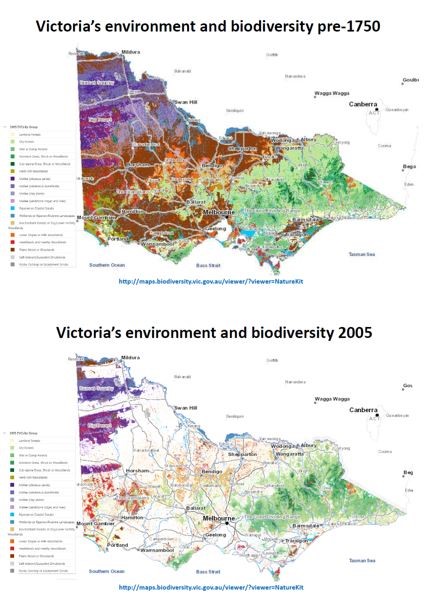
Maps showing how much the surface of the landscapes have changed in Victoria since colonisation. Reproduced with permission from: https://www.environment.vic.gov.au/biodiversity/naturekit
For tens of thousands of years Victoria’s landscapes were carefully managed by Aboriginal people to produce food, fibre and medicine. In Ballarat, the Wadawurrung people farmed many plants and animals (and in some places still do today), often using fire to weed certain areas or to promote new growth. For example, on the sunny plains they farmed the murnong – a root vegetable like a mini-sweet potato. In forest areas with lots of old trees, they farmed the brushtail possum – the meat was eaten while the pelt (the skin with the fur on) could be turned into warm, waterproof clothing. By looking after landscapes carefully, they made sure there would be plenty of murnong and possums for the next generation and the many who would come after them. Such landscapes are today called Aboriginal cultural landscapes.
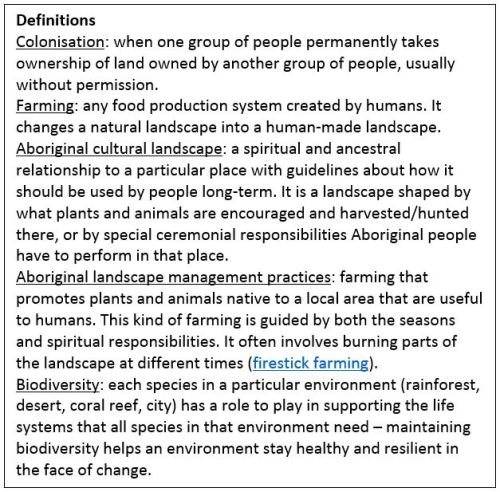 After 1835, when hundreds and then thousands of European immigrants – mainly English and Scottish people – arrived to colonise South Eastern Australia with their flocks of sheep, traditional Aboriginal lifestyles and landscape management practices were interrupted. In the following sixteen years, almost all of what came to be called Victoria was divided up and made the private property of individual European farmers (known as squatters) and their families, leaving only the largest mountains and deserts un-colonised. The huge amount of wool that was produced as a result of this was sent to the new factories of England, and made many of these squatters very rich. Some historians believe this was the fastest land-grab in human history, with fences, foreign animals and protective European farmers with guns taking over. This meant the food, fibre and medicine that was being produced across Victoria’s landscapes changed radically in a very short time.
After 1835, when hundreds and then thousands of European immigrants – mainly English and Scottish people – arrived to colonise South Eastern Australia with their flocks of sheep, traditional Aboriginal lifestyles and landscape management practices were interrupted. In the following sixteen years, almost all of what came to be called Victoria was divided up and made the private property of individual European farmers (known as squatters) and their families, leaving only the largest mountains and deserts un-colonised. The huge amount of wool that was produced as a result of this was sent to the new factories of England, and made many of these squatters very rich. Some historians believe this was the fastest land-grab in human history, with fences, foreign animals and protective European farmers with guns taking over. This meant the food, fibre and medicine that was being produced across Victoria’s landscapes changed radically in a very short time.
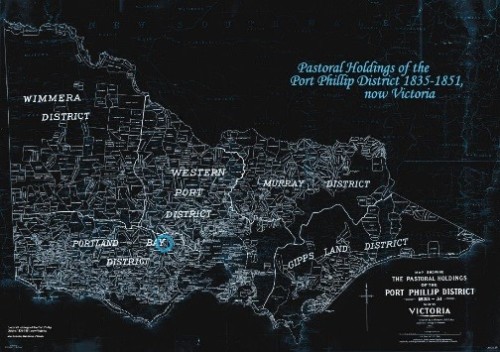
A map of Victoria which demonstrates how quickly European colonisation happened in this part of Australia. Reproduced with permission from the Gold Museum Ballarat Collection.
It is thought that the murnong was nearly extinct within 1-3 years after the arrival of sheep, because these new animals ate it and at the same time changed the nature of Victoria’s soils with their hard feet. Now, murnong is only found in a few places across the state. It fed people for tens of thousands of years (thought to have eight times more nutrition than the potatoes we buy from the supermarket today) and was a staple of Aboriginal diets all across South Eastern Australia (meaning it was eaten regularly, like most Australians now eat bread). Its sudden disappearance had grave consequences for 19th century Aboriginal communities.
The rapid changes to local landscapes left many Aboriginal people hungry. Occasionally they stole sheep, fruit and vegetables from the European farms to keep their families from starving. Some of the squatters reacted by killing the Aboriginal people who took these possessions, or any other Aboriginal people they found on or near their farms after a theft had taken place. As a result, we know that at least 69 massacres of Aboriginal people (where 6 or more people are killed at a time) occurred during the first sixteen years of European colonisation of what we now call Victoria.
Many Aboriginal people survived this period in our history – commonly called the “Squatter Era” – by adapting to the new colonial culture and economy. This often meant learning English, wearing European clothes, and eating the foods common to a European diet at the time. Due to this cultural change and a lack of access to land, Victorian Aboriginal people could no longer practice their landscape management to produce the foods, fibres and medicines of their ancestors. The old staple foods of murnong and possum had been replaced by wheat and lamb.
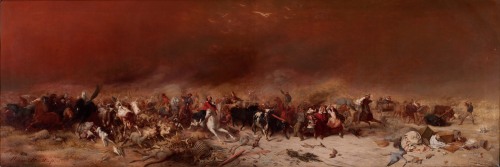
William Strutt, Black Thursday, February 6th. 1851, 1864. Reproduced with permission from the State Library of Victoria Collection. The largest fire in Victoria’s history happened in the summer of 1851. It burnt one quarter of the state, killed millions of animals, and a handful of people. Some believe this fire was so ferocious because Aboriginal people had not been able to practice traditional landscape management techniques (like firestick farming) for the 16 years beforehand, thanks to the arrival of sheep farmers. This meant that “fuel” (like dry leaves, branches, dead trees etc.) had built up across the state, making this a devastating fire both economically and environmentally.
Then, in 1851, some of Victoria’s landscapes began another transformation – the rush for gold brought thousands of new immigrants with shovels, axes and gold pans, eager to find their fortune. These gold seekers quickly multiplied (more than 500,000 new arrivals came to Victoria from all over the world between 1851 and 1861, which is the fastest population increase that Australia has ever experienced) as did the environmental change they caused to landscapes in the hunt for shiny yellow metal. Most did not plan to stay on the goldfields – or even in Australia – for long, and thought little of the lasting environmental impacts of their mining activities. Soil was upturned, rivers diverted and polluted, and trees were cut down at a rapid rate. These new arrivals all needed food, shelter and water, and took whatever could be collected from local landscapes, causing a number of plants and animals that had survived the Squatter Era to become locally extinct.
After the social change brought about by the Eureka Rebellion in 1854, many miners decided to stay and make goldfields like Ballarat, Bendigo and Beechworth, a permanent home. At this time, some local landscapes started to be protected for their beauty, or for their good soil for farming. However, this permanency also brought the Industrial Revolution to Victoria, with its wood-hungry steam engines and CO2 emissions. This transformed landscapes again. Trains, boilers, factories and foundries created urban industrial landscapes around Melbourne, Geelong, Ballarat and Bendigo which demanded yet more natural resources to be taken from local environments and re-purposed.
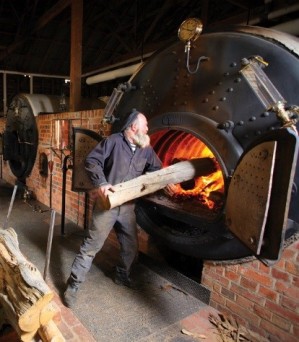
Sovereign Hill employee in the role of Boiler Attendant feeds a boiler to produce the steam to power working steam exhibits. During Australia’s Industrial Revolution, lots of communities burnt wood from local forests, instead of coal like their European equals to power their steam engines.
From this, modern Victoria as we know it today was born. There are many places across this state where sheep are still farmed, gold is still mined, and factories and foundries still operate. While Aboriginal landscape management practices were disrupted across most of Victoria for more than 180 years, in many places these practices are now being revived by Aboriginal communities and government agencies to help restore biodiversity, and manage bushfire risk. So, next time you travel around Victoria in a car/bus/train/plane, take a moment to think about how much the landscape has changed in recent history, and how it might change again in the future.
Links and References
Australia’s Aboriginal farming history in a nutshell: https://www.news.com.au/technology/environment/indigenous-historian-bruce-pascoe-says-weve-got-our-story-all-wrong/news-story/70518cd1c35efd73c126ec0c19bb8281
The National Museum of Australia has produced a free video series on Australian history, including environmental history: https://www.nma.gov.au/learn/classroom-resources/australian-journey
A free online podcast series made by La Trobe University on Australia’s environmental history: https://itunes.apple.com/au/course/australian-environmental-history/id499537077
The Australian Research Council on “Australia’s Epic Story”: https://epicaustralia.org.au/
Australia and New Zealand’s environmental history by professors Libby Robin and Tom Griffiths: https://ceh.environmentalhistory-au-nz.org/wp-content/uploads/Environmental_History_in_Australasia_2004.pdf
ANU Professor Tim Bonyhady’s take on Australia’s environmental history in “The Colonial Earth” (2003): https://www.bookdepository.com/Colonial-Earth-Tim-Bonyhady/9780522850536
The State Library of Victoria Ergo Blog on Victoria’s experiences of environmental change: http://ergo.slv.vic.gov.au/explore-history/land-exploration/environment
SBS Gold on the environmental impacts of the gold rushes: https://www.sbs.com.au/gold/story.php?storyid=124
Is modern Australian farming broken? https://theconversation.com/friday-essay-dark-emu-and-the-blindness-of-australian-agriculture-97444
An article from The Conversation called “What Australia can learn from Victoria’s shocking biodiversity record”: https://theconversation.com/what-australia-can-learn-from-victorias-shocking-biodiversity-record-113757








